- Quick Read
- Deep Read ( 7 Min. )

Why is Christian Science in our name?
Our name is about honesty. The Monitor is owned by The Christian Science Church, and we’ve always been transparent about that.
The Church publishes the Monitor because it sees good journalism as vital to progress in the world. Since 1908, we’ve aimed “to injure no man, but to bless all mankind,” as our founder, Mary Baker Eddy, put it.
Here, you’ll find award-winning journalism not driven by commercial influences – a news organization that takes seriously its mission to uplift the world by seeking solutions and finding reasons for credible hope.
Explore values journalism About usMonitor Daily Podcast
- Follow us:
- Apple Podcasts
- Spotify
- RSS Feed
- Download
TODAY’S INTRO
Pass the mic: Amplifying voices of the unheard
 Noelle Swan
Noelle Swan
A key tenet of journalism is “to give voice to the voiceless.” It’s an ideal meant to empower the powerless. But that framing takes a narrow view of power as something that must be bestowed by others and assumes that those who have been marginalized lack voices of their own.
One of today’s stories particularly embraces the spirit of that covenant but takes a different approach by amplifying the voices of five Native women. Nicole Horseherder, Kendra Pinto, Allie Redhorse Young, Charlaine Tso, and Jasmine Blackwater-Nygren represent a community that is traditionally unheard in mainstream American media and public discourse. But they are powerful, building strength from their own experiences and communities.
Our story features a series of photographic and literary portraits of each of these women, all members of Navajo Nation.
These aren’t your typical journalistic profiles, which tend to rely on the perceptions of others to flesh out the complexities that make up an individual. Instead, photojournalist Randall Hyman drove hundreds of miles across the largest Native American reservation in the United States to interview and photograph these women as they choose to present themselves. Our story focuses on their work, not to bolster their causes, but to illustrate their determination, leadership, and fortitude.
So much news coverage of Native women comes after they have suffered terrible violence. As journalists, we have an obligation to expose injustices. But at the Monitor we take equally seriously our duty to shed light on the full tapestry of humanity. When we choose to see each other as vibrant, thoughtful individuals, it becomes clear just how interwoven our threads really are.
In that spirit I invite you to spend some time getting to know these five dedicated, resourceful, and accomplished women.
I’ll let them speak for themselves.
Share this article
Link copied.

Help fund Monitor journalism for $11/ month
Already a subscriber? Login

Monitor journalism changes lives because we open that too-small box that most people think they live in. We believe news can and should expand a sense of identity and possibility beyond narrow conventional expectations.
Our work isn't possible without your support.
Smash-and-grabs, California, and the limits of criminal justice reform
Dozens of high-profile retail thefts across the United States are raising questions as prosecutors seek to balance criminal justice reform and combating modern-day organized crime.

A wave of smash-and-grabs reported in New York, Chicago, and the San Francisco Bay Area finally rolled into greater Los Angeles on Nov. 18 – with 11 such incidents in just over a week. And yet none of the people arrested is still in custody. That telegraphs a lack of consequences, say many in retail and law enforcement. Lack of accountability, they explain, encourages brazen criminal acts, and that is causing many to question criminal justice reforms led by progressive prosecutors.
Bruce Chase, assistant sheriff for patrol operations in Los Angeles County, remarks that “everybody wants a simple answer, but it is really more complex.” He cites a number of factors: deprivation during the pandemic, the civil unrest of 2020 in the wake of George Floyd’s murder by a police officer, the movement toward police reform, and communities in turmoil. “This general sense of lawlessness takes hold and the criminal element comes behind so that they feel emboldened to take advantage.”
In Beverly Hills, clothier Duke Hagenburger has nothing but praise for the way the city is handling the threat of smash-and-grabs with an increased security presence.
“The level of proactiveness in the marketplace is super effective to keeping these things down,” he says.
Smash-and-grabs, California, and the limits of criminal justice reform

Walk down Rodeo Drive with Todd Johnson, and he’ll point out security measures that are helping one of the world’s luxury centers prevent “smash-and-grab” thefts assailing shopping districts from New York to San Francisco.
Stepping close to the Gucci storefront window, he taps his knuckle against the thick glass. “Bulletproof,” says the president of the Beverly Hills Chamber of Commerce. It explains why burglars who took a sledgehammer to nearby Louis Vuitton and Saks Fifth Avenue last month were not able to bash their way into the stores before police arrived. Strolling further along the holiday-festooned boulevard, Mr. Johnson points to a tiny camera atop a traffic light. The city has upwards of 2,000 cameras – more per square foot than any city in the world, he says. “You can’t get in or out of our city without being seen.”
Then there are the things not visible to the eye: a police response time of under three minutes, and more hires, too. The police also coordinate closely with merchants, city leaders, and law enforcement agencies across the greater Los Angeles area. After an alert from the Los Angeles County Sheriff Department – and a citizen report of suspicious vehicles in the heart of Beverly Hills – Beverly Hills police arrested four suspects from a “flash mob” robbery over the Thanksgiving weekend. The suspects matched the description of a small swarm of people who descended on a Home Depot and fled with sledgehammers and crowbars. The store was 30 miles away.
“The dots were connected,” says Lt. Giovanni Trejo of the Beverly Hills Police Department.
A wave of smash-and-grabs reported in New York, Chicago, and the San Francisco Bay Area finally rolled into greater Los Angeles on Nov. 18 – with 11 such incidents in just over a week. And yet none of 14 people arrested, including the Home Depot suspects caught in Beverly Hills, is still in custody. That telegraphs a lack of consequences, say many in retail and law enforcement. Lack of accountability, they explain, encourages brazen criminal acts and is causing many to question criminal justice reforms led by progressive prosecutors such as George Gascón in Los Angeles and Chesa Boudin in San Francisco – both of whom have voters clamoring for a recall.
“We have a number of cases ready to go. We need prosecutors to prosecute these organized retail theft cases. That sends a message: ‘There will be consequences,’” says Rachel Michelin, president of the California Retailers Association.
Organized retail crime is nothing new, says Ms. Michelin, but it’s been taken to “a new level” with these mob thefts. According to a self-reported 2021 online survey by the National Retail Federation this year, about 69% of retailers said they had seen an increase in organized retail theft over the past year. They cited reasons such as the pandemic, changes to sentencing guidelines, and the growth of online marketplaces.

Similarly, 65% said gangs involved in organized retail crime are more aggressive and violent. That puts employees and shoppers in danger and has a traumatic effect on them, said Los Angeles Police Chief Michael Moore at a press conference last week. He noted that when he recently patrolled a retail area on foot with other officers, he saw a couple of women working behind a store counter start to duck down – fearing a police presence meant something bad was happening.
Organized response
Retailers are responding by sharing intelligence, hiring more private security and off-duty police, pulling high-end merchandise from their windows, stationing employees and security at entrances, and using high-tech devices, like GPS locators on merchandise to track stolen goods.
Store owners, public officials, and law enforcement are also joining forces. As Oakland Mayor Libby Schaaf told CNN recently, the thieves are coordinated, so “we need to be coordinated as well.” She says her city, which cut police, needs more officers, and state and federal law enforcement need to step up with resources and coordination.
Retailers have worked closely with California Gov. Gavin Newsom and his staff to reestablish an organized retail crime task force, and the state has boosted funding dedicated to the problem. Last month, he directed the California Highway Patrol to increase its presence near major retail sites. In the Bay Area, hit particularly hard, prosecutors have formed an alliance to combat organized retail theft.
Bruce Chase, assistant sheriff for patrol operations in Los Angeles County, remarks that “everybody wants a simple answer, but it is really more complex.” He cites a number of factors: deprivation during the pandemic, the civil unrest of 2020 in the wake of George Floyd’s murder by a police officer, the movement toward police reform, and communities in turmoil. “This general sense of lawlessness takes hold and the criminal element comes behind so that they feel emboldened to take advantage.”
In the case of the 14 suspects no longer in custody, a key factor is a pandemic-related policy of “zero bail” for some arrestees that was established by the Los Angeles County Superior Court to reduce the jail population. Police Chief Moore wants that changed.
Perception vs. reality
The issue now, as Assistant Sheriff Chase sees it, is the perception, fact-based or not, of no consequences. In an effort to end mass incarceration and inequity in the justice system, the new Los Angeles County district attorney, Mr. Gascón, has instituted reforms that drastically reduce prosecutions of low-level crimes. These reforms, says Mr. Chase, are “colliding” with a moment in which opportunists and street gangs are seizing the day with smash-and-grabs. “Thieves take calculated risks,” he says, and right now, “they feel they can get away with it.”
In a press conference marking his first anniversary this week, Mr. Gascón, flanked by progressive prosecutors from other states, argued that there is no connection between his policies and a perception of rising crime in the county. Despite the high-profile smash-and-grabs, robberies and burglaries are down in Los Angeles and the county compared with 2019. Nationally, burglary was down in the first quarter of this year compared with the same period a year ago. But murders are up substantially in the city and county – just last week, a beloved philanthropist, Jacqueline Avant, was killed in her Beverly Hills home. Nationally, a dozen cities have hit all-time high homicide records.
In California, much of the debate relating to retail theft is focused on a ballot measure passed overwhelmingly by voters seven years ago. The sentence-reducing measure, Proposition 47, lowered theft with a value less than $950 from a possible felony to a misdemeanor. Charges are often not pressed. The measure was co-written by Mr. Gascón and supported by then-Lt. Gov. Newsom.
Last year, voters continued their support for this reform by overwhelmingly rejecting a proposition that would have lowered the felony theft threshold to $250 for repeat offenders. However, Ms. Michelin, of the California Retailers Association, would like to tweak the law to allow for the aggregation of theft amounts for suspects who go from store to store.
She also says that Prop. 47 took away the ability to send some convicted thieves to a diversion program. A common tactic in organized retail crime is for criminals to tap homeless people and people with drug or alcohol addictions to do the stealing for them. These are good candidates for diversion, rehabilitation, and work-training programs that could benefit retailers, says Ms. Michelin. “We’re very much a second-chance industry. We can’t do that because of Proposition 47.”
News reports linking smash-and-grabs to the sentencing reductions of Prop. 47 greatly disturb Charis Kubrin, a professor in the Department of Criminology, Law, and Society at the University of California, Irvine. “We do not need to undo the criminal justice reforms, particularly Proposition 47,” she says.
Research, including her own, shows no connection between lowering sentences for theft and rising crime rates, she says. Since 2000, at least 39 states – including California – have safely raised the threshold required for a felony theft, according to a 2018 Pew study. As Dr. Kubrin points out, smash-and-grabs are happening even in states that don’t have a law similar to Prop. 47, such as Illinois and Minnesota. And the profile of many of the smash-and-grabs is that they are high-end, far exceeding the felony requirements. A better idea than rolling back reforms, she says, is to crack down on the online marketplaces where stolen goods are sold.
Meanwhile, Dr. Kubrin has kudos for law enforcement authorities who are stepping up patrols and coordinating across jurisdictions. “They were very quickly mobilized and are trying to figure out what’s going on.” Yesterday, Los Angeles police announced six more arrests for flash mob incidents.
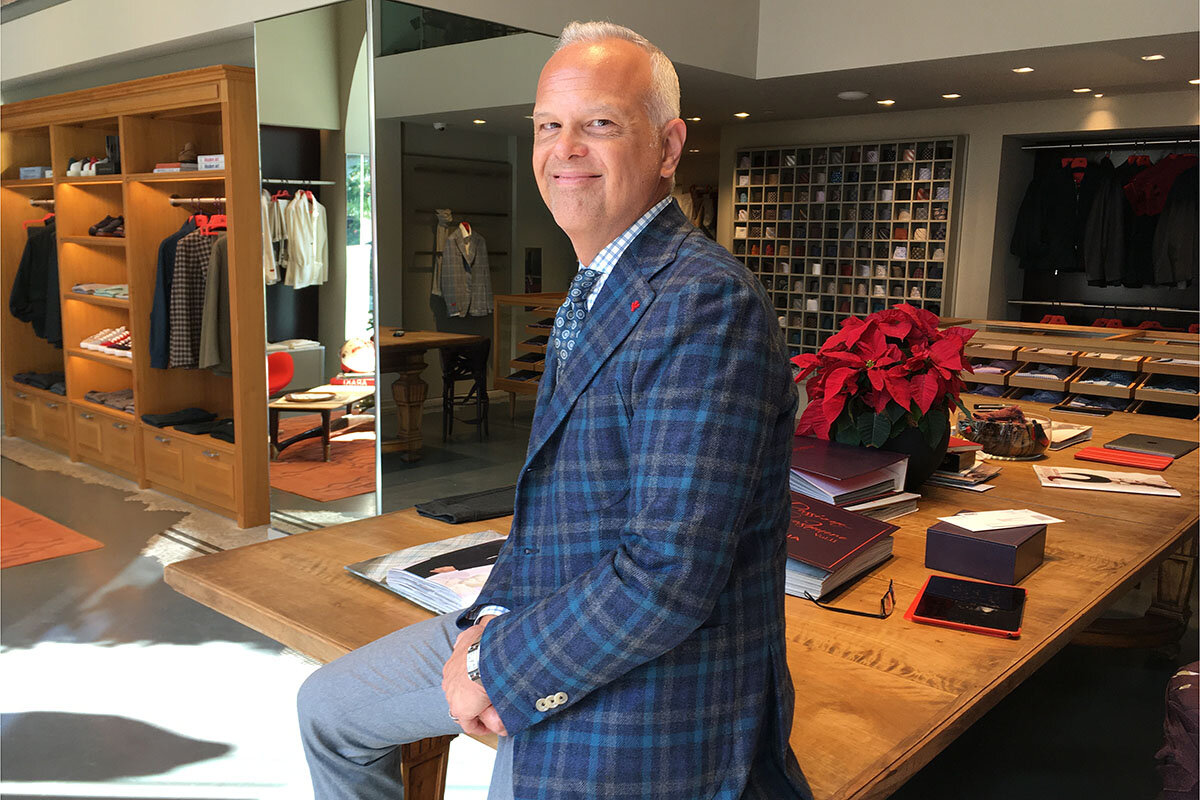
Praise from a retailer
Back in Beverly Hills, clothier Duke Hagenburger has nothing but praise for the way the city is handling the threat of smash-and-grabs. In addition to a beefed-up police department, the city has two security companies that patrol, as well as undercover “ambassadors” to keep an eye on things, he explains.
“The level of proactiveness in the marketplace is super effective to keeping these things down,” says Mr. Hagenburger, the dapper general manager of this Isaia boutique, a custom menswear business based in Italy. And in the instances that have occurred, the law enforcement response has been quick and effective, he says.
Leaning casually on a table in front of a wall of handmade, seven-fold neckties, Mr. Hagenburger notes that he hasn’t taken any extra security measures because he doesn’t feel he needs to. The city is clearly communicating its proactive and reactive strength, so that people understand it’s a safe place even in this environment, he says. “It is frankly the reason that we are in business in this market.”

A deeper look
From activism to electoral politics: Five Navajo women on the rise
Their people have suffered brutally, but these women are determined to ensure that history does not define their future. Meet five rising stars of Navajo Nation.

- Quick Read
- Deep Read ( 15 Min. )
-
By Randall Hyman Correspondent
Two environmental activists. A voting rights crusader, getting voters to the polls on horseback. And two elected officials – one as the youngest member of the Arizona State Legislature and the other as one of three women on the 24-member Navajo Nation Council.
These Navajo women are all part of a rising tide of activists on the nation’s largest reservation, making a mark on everything from energy policy to the democratic process.
Recent events highlight the need for such work: A convergence of soaring pandemic deaths, dwindling energy revenues, and rising unemployment has beset the Navajo over the past year. Uniting these women and their struggles is another factor – the dominant presence of women in Navajo society, where taking charge is rooted in a matrilineal culture.
The five female leaders recently met with the Monitor to talk about their journeys and visions for new beginnings within the Navajo reservation, a land larger than West Virginia that extends across three Southwestern states and is home to 170,000 tribal members.
“It’s that sense of taking care of the family, that role of what the Navajo woman is, and transforming it into leadership and communitywide positions,” says Arizona state Rep. Jasmine Blackwater-Nygren. “There’s definitely a sense that women are becoming stronger and more powerful voices.”
From activism to electoral politics: Five Navajo women on the rise
One who has a master’s degree in linguistics has made green energy a crusade on a reservation where coal, gas, and uranium have reigned supreme for decades, leaving tainted groundwater in their wake.
Another returned to the Navajo reservation from Chicago to find that fracking had marred large sections of her native land – something she now works to stop in one of the largest methane hot spots in the United States.
A third was so distraught by the lack of ballot access on the reservation that she organized getting voters to the polls on horseback – her version of saddle-up democracy.
Two others have immersed themselves in politics directly – one as the youngest member of the Arizona State Legislature and the other as one of three women on the 24-member Navajo Nation Council.
All are part of a rising tide of activist women on the nation’s largest reservation who are making a mark on everything from energy policy to the democratic process. Their voices echo in state capitols and corporate boardrooms across the American Southwest, trying to change business as usual within and outside the reservation.
Their efforts come at a particularly fraught time. Last year, from the vermilion sands bordering the Grand Canyon to the oil-rich scrublands east of Chaco Canyon, the Navajo Nation was hit by a perfect storm – a convergence of soaring pandemic deaths, dwindling energy revenues, and rising unemployment. Amid the chaos, Native women stepped up in what some see as an unprecedented wave. While one COVID-19 relief group raised $18 million in a matter of months, other women redoubled efforts to dismantle policies that have left Navajo (Diné) people vulnerable.
“I think that you’re actually seeing a return to the way that Diné society has always been,” says Nicole Horseherder, executive director of Tó Nizhóní Ání (Sacred Water Speaks), an organization pushing for new energy policies and water protection across the Navajo Nation. “Women are coming forward and saying, ‘I am a leader too. I can make these decisions. I can make better decisions.’”
Some of the women, while taking controversial stands, have been motivated by deprivations they’ve seen on the reservation. Others are concerned about the damage being done to tribal lands from developers’ spades and drills. But underneath all the narratives is another factor – the dominant presence of women in Navajo society, where taking charge is rooted in a matrilineal culture.
“When you see the destruction in your community, you realize you have to do something,” says Wendy Greyeyes, assistant professor of Native American studies at the University of New Mexico in Albuquerque. “So, women are empowered. A lot of that harks back to our own creation stories. Changing Woman was a very powerful deity who reflected thinking about the longevity of our existence, of the Diné people. This ideology is baked into our DNA as Navajo women – our need to care and nurture and protect our communities, our families.”
Five female leaders recently met with the Monitor to talk about their journeys and visions for new beginnings within the Navajo reservation, a land larger than West Virginia that extends across three Southwestern states and is home to 170,000 tribal members.
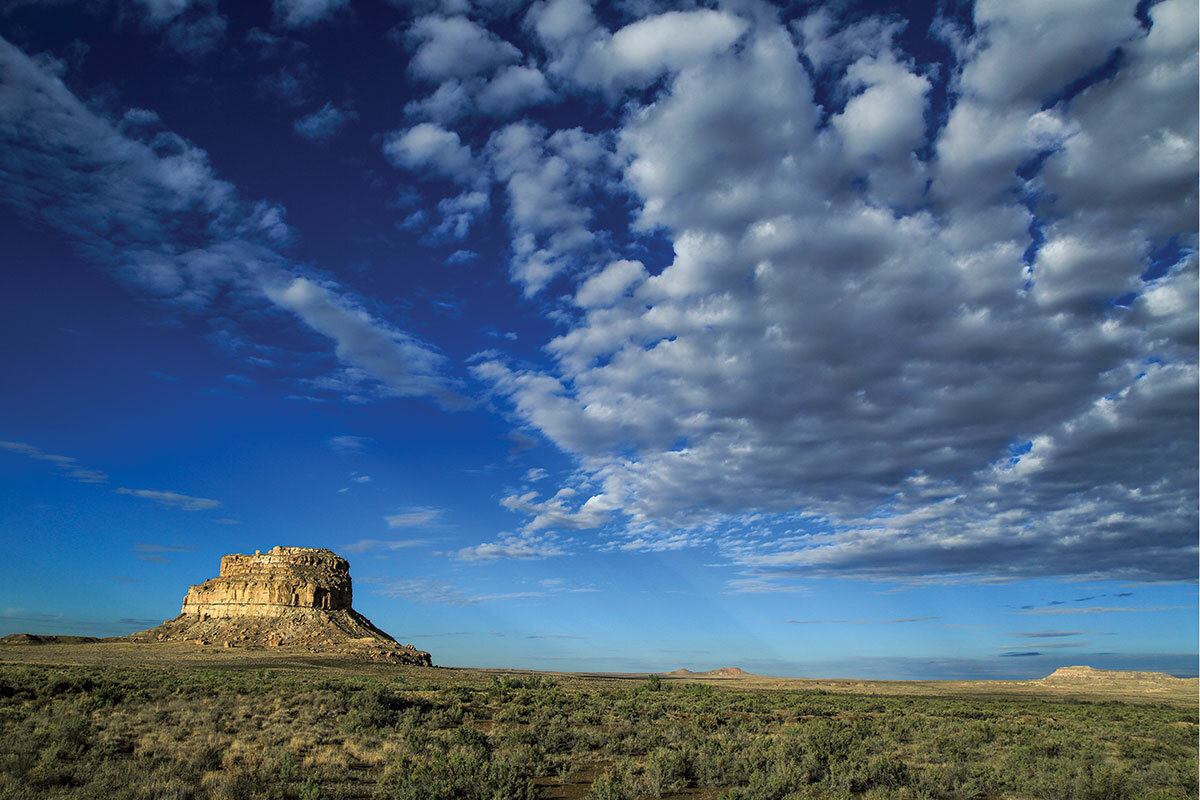
The water guardian
A year ago, on a chilly December morning, Nicole Horseherder marked an explosive turning point in her long battle against coal mining. Standing on a slope overlooking the towering smokestacks of the coal-fired Navajo Generating Station in northern Arizona, Ms. Horseherder set her cellphone on livestream and gazed at the 775-foot monoliths glowing in the sunrise a mile away.
The stacks had been a landmark of the high desert for nearly half a century, symbols of fleeting prosperity and persistent pollution. The power plant serviced major cities of the Southwest and ran the huge Colorado River pumps supplying much of their water, but was among the top 10 carbon emitters in the United States. At precisely 8:30 a.m., a thunderous rumble shattered the clear morning and clouds of smoke mushroomed as 1,500 pounds of dynamite collapsed the stacks. In the aftermath, an eerie silence gripped the crowd around Ms. Horseherder, followed by cheers of celebration from a handful of her fellow activists.
Ms. Horseherder had fought to close the power plant for years, though this moment was more a result of market forces than political pressure. When I caught up with her last August on the Second Mesa of the Hopi reservation deep within the encircling borders of the Navajo reservation, she recalled her journey’s start. Driving to an overlook, she pointed north toward distant Big Mountain. For her, it stirred painful memories.
Ownership of the hardscrabble land surrounding Big Mountain, called Black Mesa, had long been an unresolved intertribal treaty issue. It remained in limbo until the 1950s and ’60s, when a Utah lawyer named John Boyden persuaded a minority of Hopi litigants to take it to court.
True to its name, Black Mesa is underlain by rich coal seams. It is also sacred to the Navajos and Hopis, many of whom opposed outsiders tapping their minerals. But the lawsuit prevailed, eventually forcing the removal of some 10,000 Navajo residents while dividing mineral rights equally between the tribes. Boyden subsequently leased land and mineral rights for Peabody coal company. A half-century of coal mining and environmental controversy ensued.
Ms. Horseherder’s epiphany came when she returned home from Vancouver, British Columbia, with a master’s degree in the 1990s and discovered that her dream of leading a pastoral life had turned to dust. The springs that her family’s livestock depended on had run dry. “My whole attention and focus shifted,” says Ms. Horseherder. “It became, ‘How am I going to protect the place where I live – how am I going to bring the water back? And where did the water go in the first place?’ ”
Ms. Horseherder became a vocal activist and founded Tó Nizhóní Ání, or Sacred Water Speaks. At the time, Peabody was pumping billions of gallons of water from deep aquifers, mixing it with pulverized coal, and sending the slurry through 273 miles of pipeline to a Nevada power plant. It assured tribal officials that the technology was safe, and many supported the operation because coal mining was a pillar of the Navajo and Hopi economies for nearly 50 years, providing tax revenues and well-paying jobs.
But environmentalists contended that depressurizing the aquifer was lowering the water table. While Ms. Horseherder fought Peabody for years – and others lost scores of animals to stock ponds they said were tainted by slurry – the power plant and related activities were only closed when the economics of the operations no longer worked. Wells never recovered, and impacts endure to this day, critics say. “What we’d like to see them do first,” she says, “is fully reclaim those lands that they’ve mined, and reclaim the water as well. Right now, we can’t even get Peabody to talk to us.”
Peabody officials say they have reclaimed three-quarters of the land and vow to finish the task by 2027.
Having recently met with U.S. Sens. Mark Kelly and Kyrsten Sinema of Arizona, Ms. Horseherder is hopeful that the exposed land of the defunct mines will eventually be fully restored, preventing wind and rain from spreading toxic dust and heavy metals. “I want to see the Navajo Nation take a really aggressive move toward energy standards and a more intentional move away from fossil fuel,” she says. “We just have to stop making stupid decisions.”
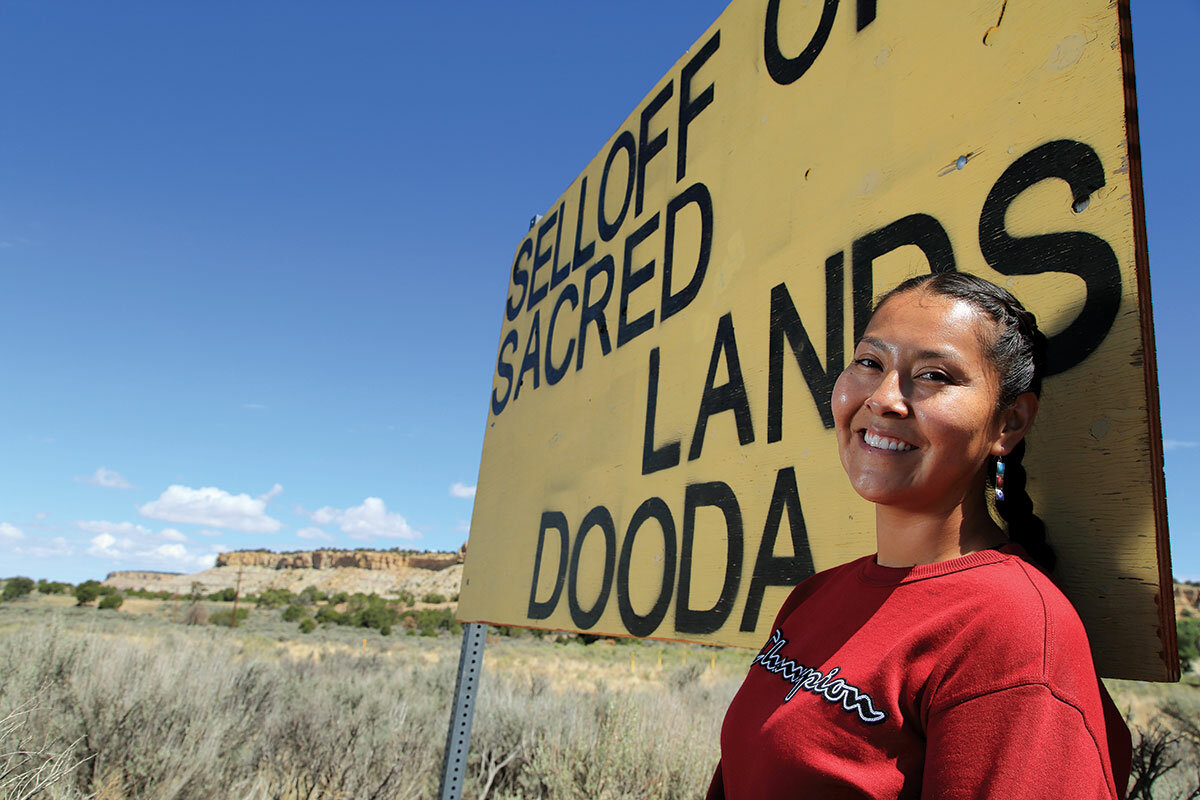
Fighting fracking, one methane leak at a time
When Kendra Pinto moved back to Navajo Nation in 2014 after three years in Chicago, she was shocked by what she found. While the coal industry had all but vanished on the western half of the reservation, oil and gas were booming in the east – and doing so with a technology called fracking.
“There was more noise; there was more traffic,” Ms. Pinto recalls. “What got my blood boiling was when I went on my favorite horse trail from my house. It’s beautiful there. You can see everything – all the way to Fajada Butte in Chaco [Culture National Historical Park]. In 2015, they cleared out a big section right in the middle of the trail, 5 acres.”
Ms. Pinto had grown up with oil drilling, but nothing on this scale. Instead of small concrete pads with squat, grasshopper pump jacks, large swaths of land were scraped clean as construction teams cut triple-wide roads through remote backcountry and poured broad concrete plazas.
With fracking in full swing, Ms. Pinto was incensed. Crews were pumping pressurized water and additives deep into shale formations to force oil and gas to the surface. The returned water contained a cocktail of drilling chemicals, yet last year the Bureau of Land Management revealed plans to expand drilling across the region, which was already 92% leased – creating up to 3,000 new wells.
Joining with other activists and a local group called Diné CARE, Ms. Pinto soon found herself testifying before Congress – but not before being arrested. In 2016, she went to Washington and participated in a small protest in the lobby of the Department of the Interior, carrying a “keep it in the ground” petition.
“It was my first action ever,” Ms. Pinto says. “It was about making a statement. We’re struggling out here, and D.C. needs to hear that.”
She and 10 other women from around the country were handcuffed, charged with a felony, and bundled into six black SUVs, with four motorcycles in front and two in back.
“They were driving us to the police station; all of the traffic was cleared, and we see everyone filming us. They were probably thinking it was somebody important. They had no idea it was just someone from the reservation.”
Important or not, Ms. Pinto returned home a changed woman. With help from various environmental groups, she began tracking methane leaks at abandoned gas wells that have proliferated as companies have moved drilling operations into the area for short periods of time and then left.
“If we can track a well site and something happens there, we have proof that it’s been having a problem that should have been taken care of,” she says. “That happens a lot around here. Out of sight, out of mind. There’s rarely oversight out here.”
In 2016 in the nearby community of Nageezi, New Mexico, something did happen, but its cause is a mystery. Late on a July evening, flames suddenly erupted amid six active oil wells, spreading across 36 tanks containing 1,800 gallons of crude oil and sending billowing black smoke skyward for days. Despite the mishap, most residents of Nageezi support new drilling leases since oil and gas provide them with valuable royalty checks. Ms. Pinto remains undeterred.
“There are those who think what I’m doing is of no use,” she says. “I actually had an elder man ask me, ‘Why are you fighting so hard? The Diné people are going to be extinct in a hundred years.’ ”
The fracking industry faces threats from bottom lines as much as from committed activists. Before the current run-up in energy prices, more than 250 oil and gas companies in North America had liquidated between 2014 and 2021, according to Haynes and Boone, a firm that tracks energy company bankruptcies.
Yet even if the industry booms again, as energy prices rise, Ms. Pinto intends to keep fighting. She is making herself heard from the reservation to Washington.
“They’ve always put a price tag on our forehead, and just expect us to be quiet,” she says, standing beside one of the bold signs that she and colleagues erected along the region’s main highway protesting the loss of sacred lands.
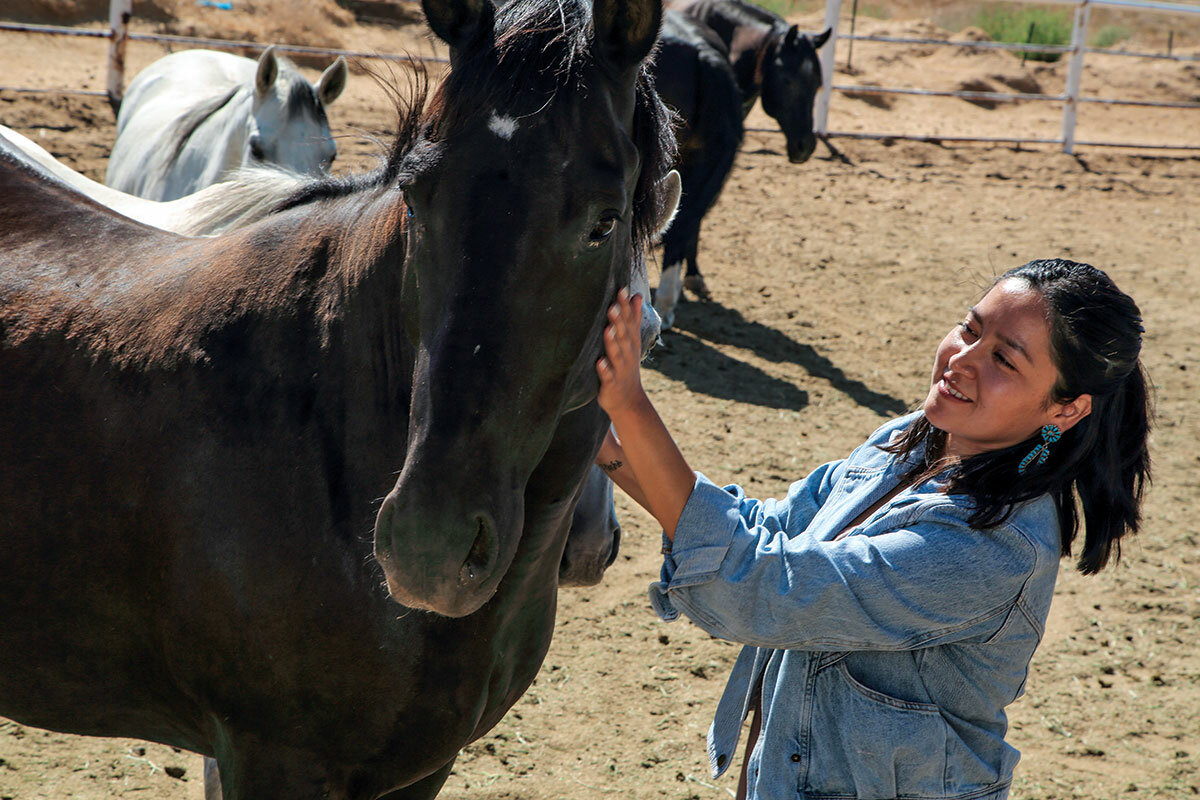
Pushing voting, from the back of a horse
Two weeks before last year’s presidential election, Allie Redhorse Young led voters to polling stations in a novel way – on horseback. She and other organizers called it Ride to the Polls, and they were sending a message to Washington about inequities on the Navajo reservation, where a dearth of voting stations, short polling hours, and poor mail service are obstacles to voting. Only 27 post offices serve the entire Navajo Nation – encompassing 27,000 square miles – and delivery is legendarily slow.
I recently met Ms. Redhorse Young outside Farmington, New Mexico, in a dusty town called Kirtland on the San Juan River. Wearing cowboy boots, a skirt, and a denim jacket, she climbed into the corral behind her grandfather’s hogan, coaxing several horses forward. By her account, Ride to the Polls was the realization of her father’s dream about Navajo riders saddling up to heal tribal divisions and her own dream of giving back to a nation she’d left years earlier to attend boarding school and Dartmouth College.
“Some people came from parts of the res that are in remote locations and met us there and then rode in with us,” says Ms. Redhorse Young. “But it was really to make a statement – especially to Native young voters – that this is what our ancestors had to do and that, yeah, some of us maybe don’t have transportation. But if our grandparents and our ancestors saddled up to get to the polls, then we should exercise our right to vote, the right that they fought for.”
The first Ride to the Polls was Oct. 20, 2020, in Arizona, where her father lives and from whom she borrowed horses. With another planned the following week, Ms. Redhorse Young discovered that Navajo Nation polling stations closed 10 days earlier than the rest of the state. She ended up leading the second Ride to the Polls on Election Day, attracting national headlines. Diné and Hopi voters turned out in force that day, casting nearly 60,000 ballots that were overwhelmingly Democratic. Their vote proved pivotal in helping Democrat Joe Biden win by a slim margin of 10,000 votes in the state.
Since then, Arizona Republicans, saying they’re worried about fraud, have passed laws that they argue will safeguard the system, placing restrictions on such things as early voting and mail-in ballots. Critics say it’s just a form of voter suppression that particularly disadvantages voters in remote areas, like many Diné, with poor infrastructure, no formal address, or limited transportation.
Ms. Redhorse Young’s new foundation, Protect the Sacred, in addition to promoting voting rights on the reservation, also supports programs that preserve the knowledge of Indigenous elders, dying languages, and traditional medicinal arts. “Both my maternal and paternal grandfathers are medicine men,” she says, adding, “Those cultural roots are what brought me home.”
Her work since returning to the res has been nationally recognized, including meeting in Washington with Vice President Kamala Harris two weeks before my visit to discuss Native American voting rights. She was one of just five Native leaders invited for the private audience. With midterm elections ahead, Ms. Redhorse Young worries about Navajo youth, many of whom believe that voting is akin to embracing white values.
“But I say, look at what we’ve been able to accomplish,” she says. “[Interior] Secretary [Deb] Haaland is the first Native American Cabinet member confirmed – and by the administration that we put into office.”
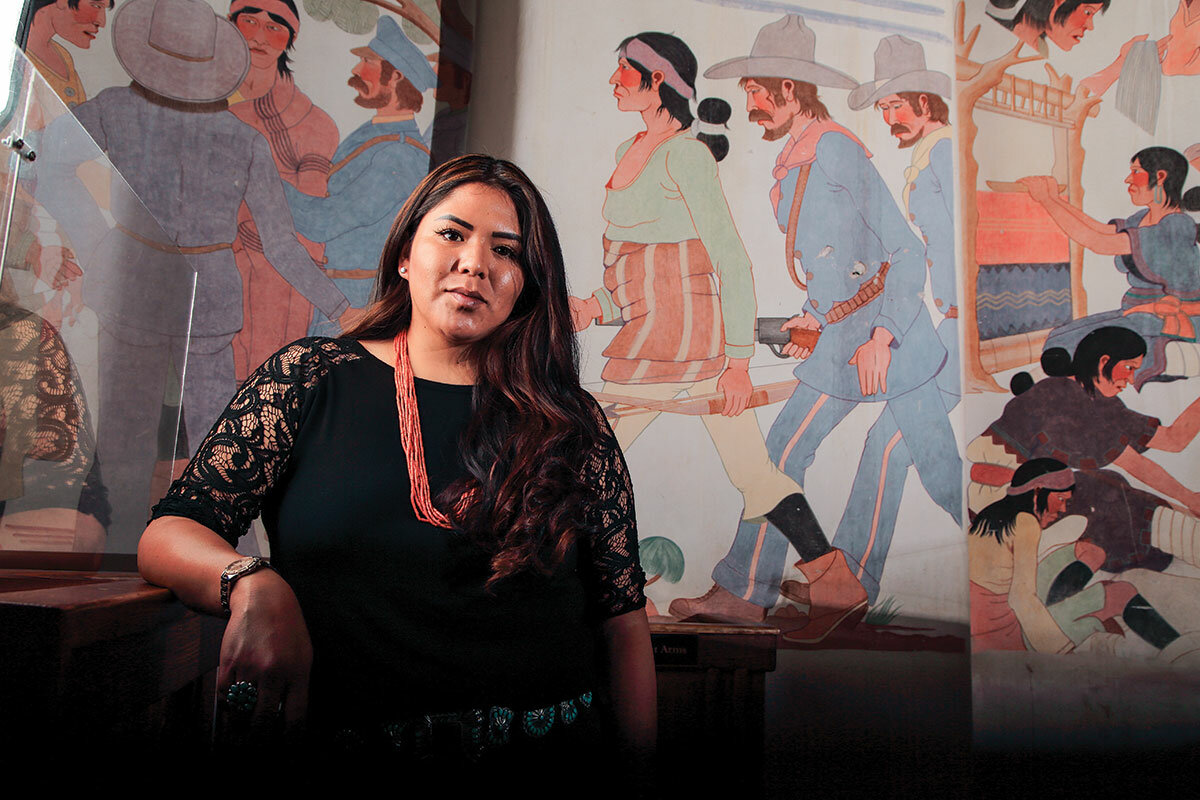
Out of tragedy, a passion for helping
Charlaine Tso, a delegate on the Navajo Nation Council, knows what remote is, and I get a taste of it following her for half an hour on red-dust roads that crisscross the hard-baked land of the Southwest.
When we finally arrive below a line of soaring mesas, Ms. Tso sits outside her modest home describing her childhood in a household led by her mother and grandmother, who is still active at 103 years of age.
As a school principal, her mother would drive 90 minutes to work every day while Ms. Tso helped her grandmother herd sheep. She eventually attended her mother’s school and saw leadership close up, returning each evening to a home with no electricity or running water – as is true for more than 30% of the Navajo reservation today.
“It wasn’t until I left for college that we got electricity,” says Ms. Tso. “And water we didn’t receive until my junior year in high school. We hauled water from the windmills. It was very tough.”
Ms. Tso faced a new kind of hardship upon graduation. Shortly after her return home, a drunken driver hit her head-on along the same highway we had just been traveling. She was bedridden for months, found Christianity, and regained her mobility.
Several years later another tragedy prompted her to run for office. In her district, a harsh winter storm marooned an older woman in a remote home with no food and no firewood. Days after the weather cleared, her relatives found her frozen to death. Ms. Tso learned of the tragedy the next weekend while visiting from Albuquerque, New Mexico.
“I was, like, firewood? So much money is given to our tribe as assistance to our elders and our seniors. I was just so livid. Where were our leaders? I went back to Albuquerque and it stuck with me. I couldn’t concentrate. I called my mom and said, ‘Mom, when is the next election for council delegate?’ ”
With fluency in Navajo, she attracted many elders and prevailed in 2019 against three male candidates to become the youngest of only three women on the 24-member Navajo Nation Council, the highest body on the reservation.
While some of her votes in the Navajo capital of Window Rock have invited criticism, she is steadfast in championing issues such as elder care, missing and abused Native women, and education. She rails about federal pandemic funding that remains unspent because of infighting on the tribal council, and then makes a bold prediction about the place of women on the reservation.
“Once it all comes crumbling down, there will be one woman that will be elected to the Navajo Nation,” she says. “It’ll be history and she will turn everything around. That’s what has been told by our elders.”
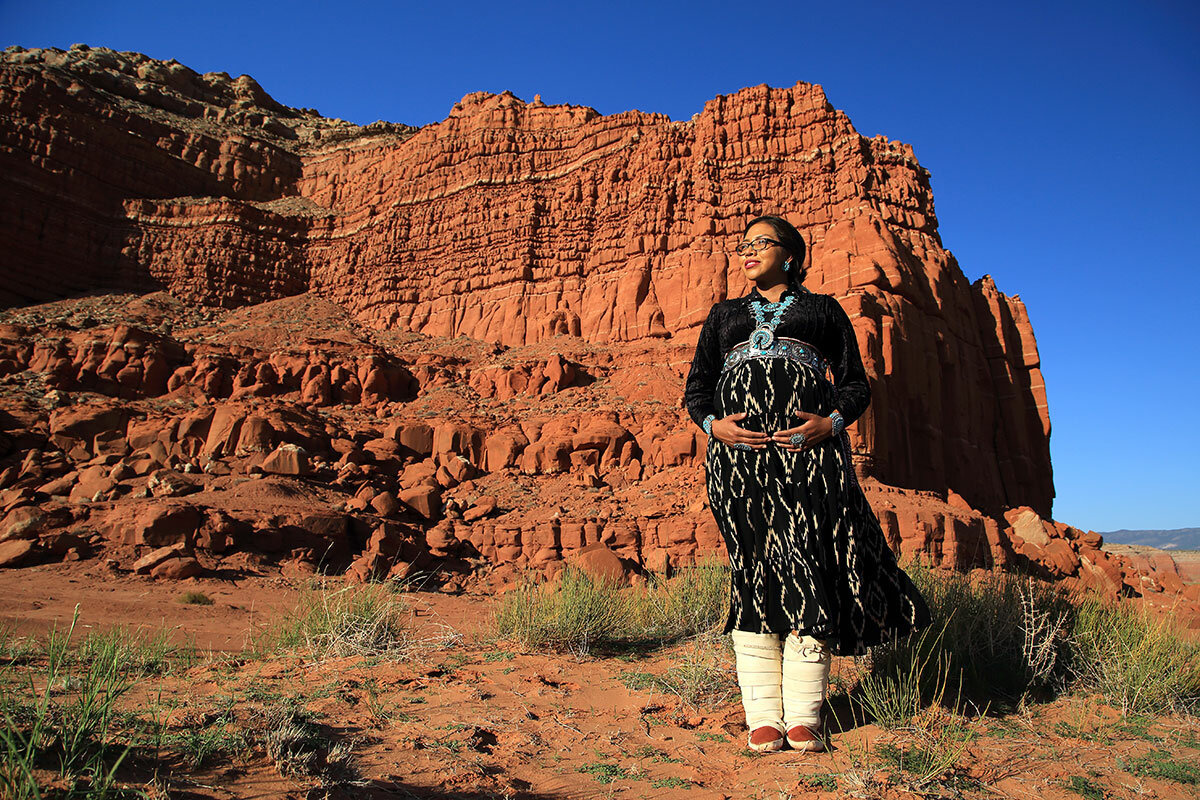
A champion of native rights
Dressed in resplendent Navajo garments, Arizona state Rep. Jasmine Blackwater-Nygren stands before a towering mesa as it burns brilliant red against a cobalt sky in the setting sun. She is on her grandmother’s land – a refuge for her after months of political wrangling in Phoenix. Her grandmother, who never attended school, looms as an inspiration.
“As the eldest, she stayed home and had to herd sheep and take care of the family,” says Ms. Blackwater-Nygren. “She watched all of her younger siblings go on to high school and college and become teachers and nurses in the community, so in her mind she feels like she missed out on that opportunity to be something.”
Her grandmother’s sacrifice encouraged Ms. Blackwater-Nygren to get an undergraduate degree from Stanford University, go to law school, and pass the Arizona bar exam. She became the youngest member of the Arizona House of Representatives when she was appointed to the seat vacated by Arlando Teller, a member of the Navajo Nation, who resigned in January to join the Biden administration. She is a champion of education for Native youth and voting rights.
“I knew that as a Democrat I was going to be in the minority party and that meant working across the aisle to get anything done,” says Ms. Blackwater-Nygren. Unfortunately, she adds, Republicans had their own agenda, pushing restrictive voting bills. “I spoke out against those bills. Native American voters across the board have the lowest voter turnout, period, of any minority group, and any voter suppression bill will only exacerbate that disparity.”
Ms. Blackwater-Nygren wants to expand Native-owned solar energy projects. She also shepherded a bill through the House, which the governor has signed, allowing Native students to wear traditional attire at high school commencements. Mr. Teller originally introduced the bill after a Phoenix student was excluded from graduation for adorning her cap with regalia.
She supported another bill, now law, creating an Arizona holiday honoring Navajo Code Talkers, like her grandfather, who used their traditional language to transmit secret messages during World War II.
As a new mother, Ms. Blackwater-Nygren thinks a lot about her place in Navajo society amid persistent unemployment, substance abuse, and violence against women. “It’s that sense of taking care of the family, that role of what the Navajo woman is, and transforming it into leadership and communitywide positions. There’s definitely a sense that women are becoming stronger and more powerful voices.”

Retire on campus? Colleges find community with intergenerational living.
How do you break down stereotypes across generations? If this senior living residence on a university campus is any indication, proximity may be key.
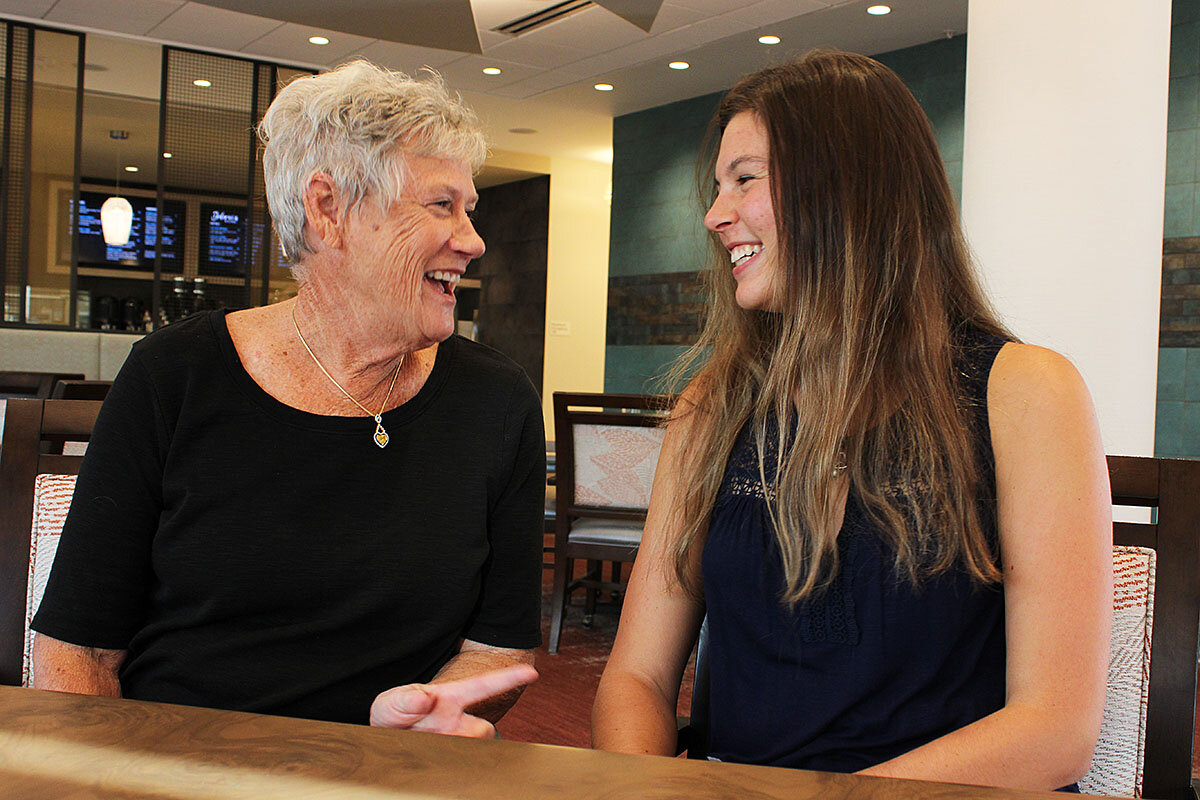
- Quick Read
- Deep Read ( 6 Min. )
Deven Meyers and Pencie Culiver are both familiar with Arizona State University’s Tempe campus. Ms. Meyers is a student there; Mrs. Culiver lives there – in Mirabella at ASU, a senior living residence that opened last December.
With perks like access to classes and campus IDs, Mirabella is billed as an immersive alternative to traditional lifelong learning. Some residents have moved there from across the country, while several have ties to the university as alumni or former employees. Whatever their background, retirees here are convinced they have more to give, rejecting a mindset of decline for one of usefulness and growth.
Mirabella’s Executive Director Tom Dorough believes interactions across generations can help chip away at ageism.
“The more intergenerational opportunities that we have where we’re connecting younger adults to older adults, I think the better the understanding is,” he says.
That’s borne out by Ms. Meyers and Mrs. Culiver at a get-together in Mirabella’s street-level bistro one October afternoon. The women joke around as if pals forever – no matter their ages are decades apart.
“She energizes me. She gives me hope for the future,” says Mrs. Culiver of her new friend.
“Honestly, it’s just fun to hear her stories,” says the business health care major.
Retire on campus? Colleges find community with intergenerational living.
Ruth Jones lives on top of the world – her world, anyway.
From nine stories high, she can gaze down at a sun-smothered, urban Arizona sprawl featuring a school she began serving in 1981 – the top of an auditorium here, her last faculty office there.
The former political science professor is so fond of Arizona State University that she retired on campus.
“One of my former professors said, ‘Stay on campus as long as you possibly can. … Because those students will keep you young,’” she recalls. “I realized the wisdom in what he said.”
Dr. Jones lives in a high-end, intergenerational senior living residence that opened on the Tempe campus last year. With perks like access to classes and campus IDs, Mirabella at ASU is billed as an immersive alternative to traditional lifelong learning. Retirees here are convinced they have more to give, rejecting a mindset of decline for one of usefulness and growth.
Take Karen Busch, for example. She’s embracing life at Mirabella after tough pandemic months and the death of her husband.
“I feel now like I have a much better purpose again to life,” says the senior with spiked, rose-colored hair.
But seniors aren’t the only ones benefiting.
Intergenerational living: A two-way street
Pencie Culiver and Deven Meyers both wear thick watches on their left wrists. At Mirabella’s street-level bistro one October afternoon, they joke around as if pals forever – no matter their ages are decades apart.
Mrs. Culiver, a Mirabella resident, shared burgers with her future husband at ASU football games in the ’60s. Now back living on campus, she and Ms. Meyers, an ASU student, sometimes do double dates.
“She energizes me. She gives me hope for the future,” says Mrs. Culiver of her new friend.
“Honestly, it’s just fun to hear her stories,” says the business health care major.
They were paired through an intergenerational “pen pal program,” though they prefer meetups over missives. As director of lifelong university engagement, Lindsey Beagley is tasked with promoting such cross-campus exchanges.
“I do think part of my job is to challenge assumptions on both sides, right? About the different generations,” she says.
Mirabella’s sleek 20-story tower opened its doors last December. Surrounded by traffic and eateries, it sits on the urban edge of the Tempe campus, which hosts roughly 55,000 students. U.S. News and World Report ranks ASU first for innovation.
“We believe strongly at ASU in the idea that we should all be lifelong learners,” says Morgan Olsen, executive vice president, treasurer, and chief financial officer of the school.
Mirabella’s couple-hundred residents, ages 62 and older, are largely white and presumably well-off. (Entrance fees range from $382,400 to over a million dollars, on top of monthly service fees up to $7,800.) Some residents have moved there from across the country, while several have ties to the university as alumni or former employees, like Dr. Jones, who mentions enjoying an undergrad course on world religions and recreational art classes at Mirabella.
“They say to get outside your comfort zone,” she says at home, enthroned on a yellow leather recliner. “No greater discomfort than taking a watercolor class.”
By staying on campus, Dr. Jones also gets to witness her professional legacy unfurl. As the first tenured woman in the political science department as well as the first to serve as its chair, she recruited several women to ASU during her career – a point of pride for the retiree.
“It’s not hard to recruit good women,” she says. “It’s hard to create the environment that will help them succeed,” adding that she maintains casual meetups with some of the women still there.
Down the hall lives Dr. Busch, with the short, soft-pink hair, a retired director of faculty development who moved from Michigan. This spring she launched a weekly conversation group in Spanish that she hopes more students will join.
Another Mirabella resident, Richard Ruff, who, with his wife, Janet Spirer, divides his time between here and San Diego, also connects with students on academic topics. A retired organizational psychologist, he mentored students this past semester through the Center for Entrepreneurship. Along with helping him feel purposeful, the gig afforded him welcome insight into kids these days.
“They’re scary smart,” says a gray-sweatered Dr. Ruff.
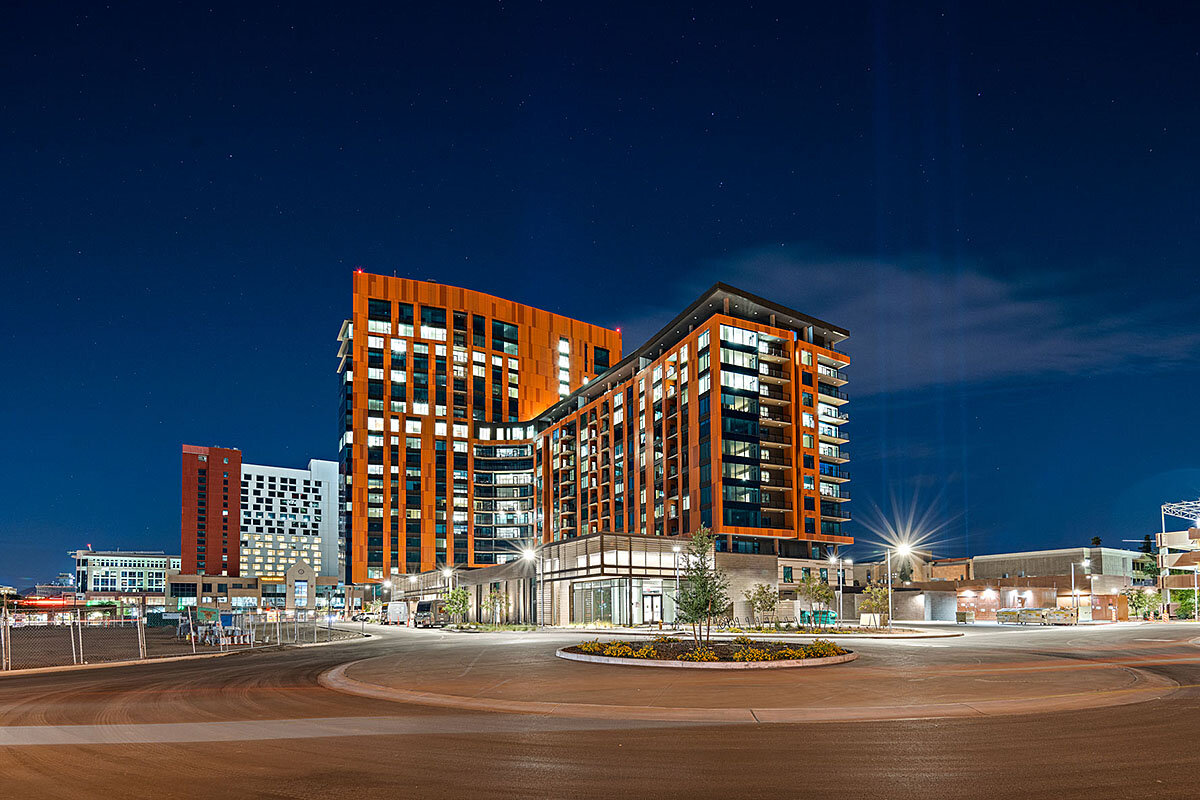
A growth path for campuses?
Older adults seek three things, says Andrew Carle, a senior living and aging industry consultant: “They’re looking for active, they’re looking for intellectually stimulating, and they’re looking for intergenerational retirement environments. And basically, I just described a college campus.”
One estimate counts around 100 higher ed-affiliated retirement sites. But Mr. Carle, who coined the term “university-based retirement communities” (UBRCs), says only three or four dozen projects meet most of his criteria.
The ASU model is unusual for its on-campus location and close affiliation with the school, he adds. Boston-area Lasell Village is another example, where residents on Lasell University’s campus commit to at least 450 hours of enrichment a year.
Given declining enrollments – and potentially more empty buildings if virtual learning expands – UBRCs can increase campus-based revenue, Mr. Carle argues.
“I said to one university president … ‘You can hopefully start giving birth to baby geniuses who start college at age 5, or you can recycle your old customers.’”
ASU leases the nearly 2-acre site to a joint venture managed by Pacific Retirement Services. The 99-year land lease cost around $7 million up front, plus the joint venture pays a semiannual fee.
As a life plan community, Mirabella offers multiple levels of care. Beyond the 238 independent living residences, a few dozen units are dedicated to assisted living, skilled nursing, and memory care, though the latter hasn’t opened yet due to industry-wide staffing shortages.
Other growing pains stem from its location. In October, Mirabella filed a lawsuit against Shady Park, a live music venue across the street, asking Maricopa County Superior Court for an injunction to keep it from emitting noise above local limits.
Mirabella alleges the venue’s noise and vibrations have caused “substantial personal harm” to residents, though the city says the venue, which predates Mirabella, hasn’t been cited for noise violations. A judge denied Mirabella’s request for a temporary restraining order last month.
“Discovery is ongoing but we are confident that when the facts are developed they will confirm that the sound created by music at Shady Park is reasonable and appropriate,” emailed Shady Park spokesman David Leibowitz.
Despite some friction, having both retirees and college-age concertgoers wanting to call Tempe home is “a great problem to have,” says Deputy City Manager Rosa Inchausti.
Senior advocates agree that the benefits of proximity outweigh the hiccups.
Counteracting ageism
Mirabella’s Executive Director Tom Dorough believes interactions across generations can help chip away at ageism.
“For whatever reason, in Western culture, we kind of push older adults to the side like they’re no longer useful,” he says. “The more intergenerational opportunities that we have where we’re connecting younger adults to older adults, I think the better the understanding is.”
To encourage that interaction, Mirabella pays room and board for four student musicians-in-residence. In exchange, they dedicate at least two hours a week to performance or other programming, like lessons.
At a late-summer Mirabella happy hour, musician-in-residence Michelle Kim was playing the piano when she says a man encouraged her to choose a favorite tune of her own. A couple months later, she still recalls the group’s applause as her fingers sank into the opening keys of “Autumn Leaves.”
“They’re so compassionate,” says Ms. Kim, who’s pursuing a doctorate of musical arts. After months limited by COVID-19, “it’s so nice to have a regular audience – and your fans.”
“I’m just so grateful to work with the residents,” she adds. “They’re literally like my grandparents.”
It’s a familiarity similar to what Ms. Meyers and Mrs. Culiver share. As they prepare to leave the Mirabella bistro, the two mention a plan to reunite for sandwiches soon.
Then they hug goodbye.

Film
‘National Champions’ asks: Should college athletes be paid?
How far would you go to stand up for a principle? The film “National Champions” weighs the trade-offs of taking a firm stance – including the loss of money, status, and close relationships, says the Monitor’s chief culture writer.

‘National Champions’ asks: Should college athletes be paid?
In the football movie “National Champions,” we never see the athletes set foot on the field. The entire story takes place inside hotel rooms and conference rooms. It’s like setting a movie about astronauts entirely inside NASA’s Houston control room.
It’s not so much a sports movie as it is a morality play. “National Champions” poses the question: How far would you go to stand up for a principle? It weighs the trade-offs of taking a firm stance – including the loss of money, status, and close relationships.
The story begins 73 hours prior to a championship title game in New Orleans. One of the two teams, the (fictional) Missouri Wolves, is poised to win the first-ever title for veteran coach James Lazor (Oscar winner J.K. Simmons, taking a break from Farmers Insurance ads). Its quarterback, LeMarcus James (Stephan James), is expected to become the No. 1 pick in the NFL draft. But LeMarcus has more on his mind than being immortalized in a future Madden video game. He tweets that he’s not going to play in the championship unless the NCAA starts paying college athletes.
“All of this money is predicated on one underlying principle: free labor,” LeMarcus declares. “It’s un-American, it’s exploitative, and it speaks to the darkest spots of the national soul.”
The young Black player is alluding, of course, to slavery. The movie raises issues of racial inequality, but it also resists depicting Black people as victims without agency. At one point, an NCAA official offers a Black assistant coach an opportunity to take over from Missouri’s Lazor. But the assistant isn’t interested in the tokenism of becoming the first Black coach in a championship game. “I’m one of the best assistant coaches in this country. I don’t need a handout,” he says.
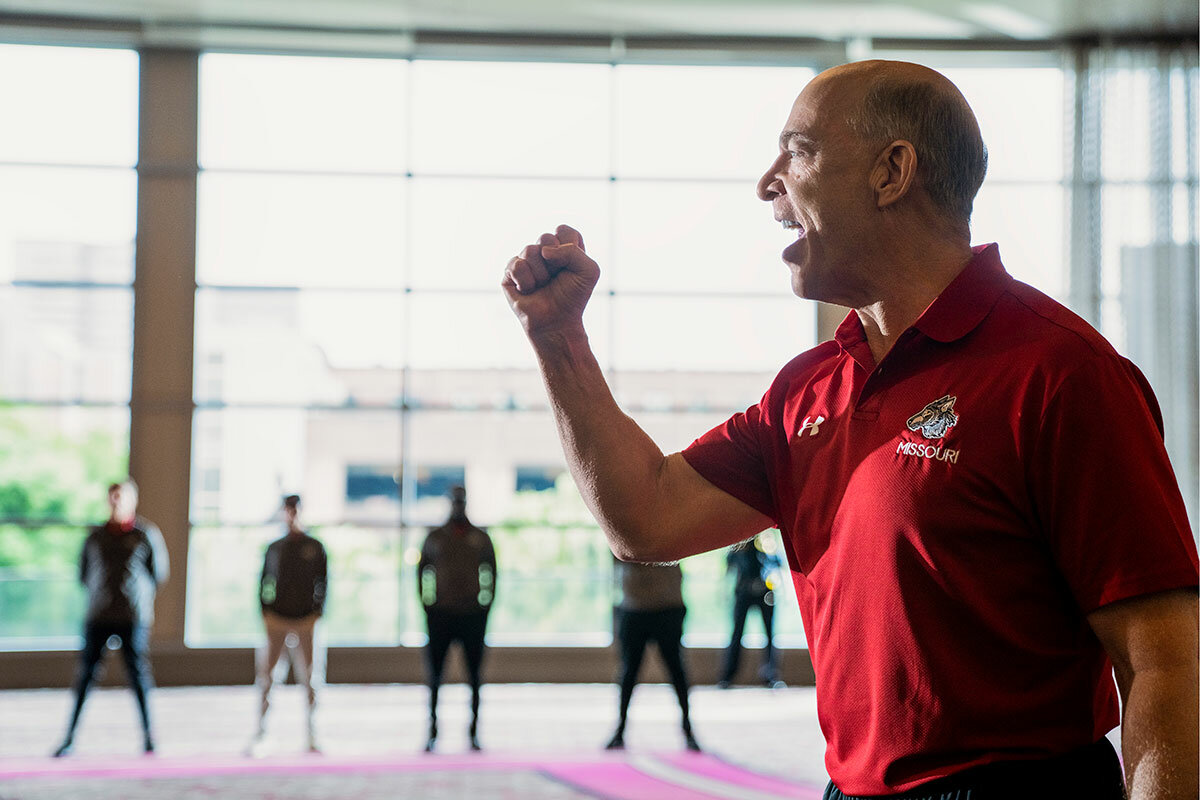
At first, “National Champions” plays too much like a didactic TED Talk – but with so much profanity that you’d think the screenwriter was getting paid by the F-word. In a series of speeches and press interviews, the quarterback relays figures about how much money the NCAA and its officials make. He lays out a detailed manifesto for reform. LeMarcus and teammate Emmett Sunday (Alexander Ludwig) persuade more players to join the boycott, marshaling their campaign from a hidden location. The NCAA feels as if it’s been held hostage, so it calls in a negotiator, lawyer Katherine Poe (Emmy winner Uzo Aduba). Her hard-hitting style would make an offensive tackle backpedal.
The hitherto polemical script by Adam Mervis, who also wrote the stage play the film is based on, becomes infinitely richer by embracing complexity as Katherine digs up information about LeMarcus’ past. (It’s possible that the film’s overly drab gray color palette is metaphorical – issues aren’t always black or white.) Katherine also offers a counterargument to the professionalization of college sports. She confronts the quarterback in a captivating performance that merits Oscar consideration for Aduba.
“You think I don’t know what it’s like to be without heat in your house? That I don’t know what it’s like to not be able to afford your jersey, as you’re avoiding your coach because you don’t have the $50 to pay for it?” she says, revealing that she once had a full-ride track scholarship at Duke. She took the money to escape poverty.
If the NCAA starts paying college athletes, she muses, what would it mean for less popular – and thus less financially lucrative – sports that aren’t basketball or football? What would be the fate of volleyball in Minnesota, soccer in Idaho, or softball in South Carolina, and all the students who might no longer get a leg up by going to college?
“National Champions” hurtles to an effective climax in which LeMarcus must weigh whether he can reach a win-win compromise with the NCAA and play in the big game. By peeling back the layers of the characters on both sides of the issue, the movie offers a potent reminder that, often, policy debates become mired in talking points. The danger is that we’ll miss the human stories at the heart of such matters.
“National Champions” is rated R for language throughout and sexual references.
Other headline stories we’re watching
(Get live updates throughout the day.)The Monitor's View
Healing the Russia-Ukraine faith divide
- Quick Read
- Deep Read ( 2 Min. )
-
By the Monitor's Editorial Board
Last July, just before he sent troops to the border with Ukraine, Russian President Vladimir Putin wrote, “Our spiritual unity has also been attacked.” To Ukrainians, the meaning was clear. Mr. Putin remains upset over the creation of an Orthodox church in Ukraine two years ago, one that is now independent of the Russian Orthodox Church. He even equated this attempt at a separate Ukrainian identity as the “use of weapons of mass destruction against us.”
Mr. Putin cites many reasons to keep Ukraine within Russia’s orbit of influence. Yet the historic religious ties between the two countries remain the most emotional. While Western leaders have tried to end Kremlin aggression against Ukraine with threats of sanctions, little has been done to address the underlying religious schism.
In late November, however, when fears of an invasion were high, the head of the Russian church, Patriarch Kirill, said that the problems with the new Ukraine church may be resolved by dialogue.
If Ukraine is to remain an independent state, one important task is to help church leaders on each side look first at the core principles of their faith, such as love. Such principles can never be under spiritual attack.
Healing the Russia-Ukraine faith divide

Last July, just before he sent some 100,000 troops to the border with Ukraine in an apparent preparation for an invasion, Russian President Vladimir Putin wrote, “Our spiritual unity has also been attacked.” To Ukrainians, the meaning was clear.
Mr. Putin remains upset over the creation of an Orthodox church in Ukraine two years ago, one that is now independent of the Russian Orthodox Church. He even equated this attempt at a separate Ukrainian identity as the “use of weapons of mass destruction against us.”
Mr. Putin cites many reasons to keep Ukraine within Russia’s orbit of influence. Yet the historic religious ties between the two countries remain the most emotional, especially among millions of Orthodox Russians. While Western leaders have tried to end Kremlin aggression against Ukraine with threats of sanctions, little has been done to address the underlying religious schism.
In late November, however, when fears of an invasion were high, the head of the Russian church, Patriarch Kirill, said that the problems with the new Ukraine church may be resolved by dialogue. “Schisms are always, of course, overcome at some point,” he told Rossiya 1 television station.
“The hope remains that both by the grace of God and by the efforts of clergy it will be possible ... to begin dialogue ... and to agree on something,” he said.
Something similar was stated by Ukrainian President Volodymyr Zelenskyy. He has called on both churches to engage in negotiations. “Faith should unite, and not divide,” he said.
In many parts of the world, interfaith dialogue is often essential to bringing peace. With last year’s Abraham Accords in the Middle East, for example, a dialogue has opened between Israeli Jews and Gulf Arabs. During a visit to Cyprus this month, Pope Francis told Greek Orthodox leaders on the island, “Where our relations are concerned, history has opened broad furrows between us, but the Holy Spirit desires that with humility and respect we once more draw close to one another.”
The Ukraine crisis puts a spotlight on the need for greater diplomatic attention to religious divides. In a paper last month by the U.S. Institute of Peace, scholars Peter Mandaville and Chris Seiple wrote:
“While the common tendency among many observers of global affairs to view religion as a source (or ‘driver’) of conflict undoubtedly persists, it is increasingly clear that achieving sustainable peace and stability in most settings depends on the ability to involve religious actors ... in that process.”
If Ukraine is to remain an independent state, one important task is to help church leaders on each side look first at the core principles of their faith, such as love. Such principles can never be under spiritual attack.

A Christian Science Perspective
Each weekday, the Monitor includes one clearly labeled religious article offering spiritual insight on contemporary issues, including the news. The publication – in its various forms – is produced for anyone who cares about the progress of the human endeavor around the world and seeks news reported with compassion, intelligence, and an essentially constructive lens. For many, that caring has religious roots. For many, it does not. The Monitor has always embraced both audiences. The Monitor is owned by a church – The First Church of Christ, Scientist, in Boston – whose founder was concerned with both the state of the world and the quality of available news.
where other than here?
- Quick Read
- Read or Listen ( 1 Min. )
-
By Joni Overton-Jung
Wherever we may be, we can welcome and bear witness to God’s ever-present goodness, love, and truth, as this poem conveys.
where other than here?
where would i rather be
than here?
for where other than here
can there be all –
all that can be sought,
wanted,
hoped for –
where other than here...
for here
right here
God is.
God, the “I” of all being: I am
and would i not rather be
“doorkeeper in the house of my God” –
to welcome, receive, witness, embrace
all that Love is calling forth,
all that Life is sending,
Truth revealing –
than any possible other thing?
(“For a day in thy courts is
better than a thousand....”)
this is no dormant day
there is no withholding
no need for wondering or waiting
for good to come,
throw wide the door
behold
give thanks
say yes
open your hands
the great Giver gives
Originally published in the November 2021 issue of The Christian Science Journal.

A message of love
The Great Wave

A look ahead
Thanks for joining us today. On Monday, Harry Bruinius looks at what the rise in chosen singlehood means for the U.S. going forward.
Also, check out the latest episode of our “People Making a Difference” podcast. Kenyan Susan Murabana has reached about 200,000 African children with her portable planetarium and telescope. Her mission: Give equal access to the skies and inspire curiosity and awe in the next generation of Kenyan scientists. (Bonus: It’s also a love story.)


